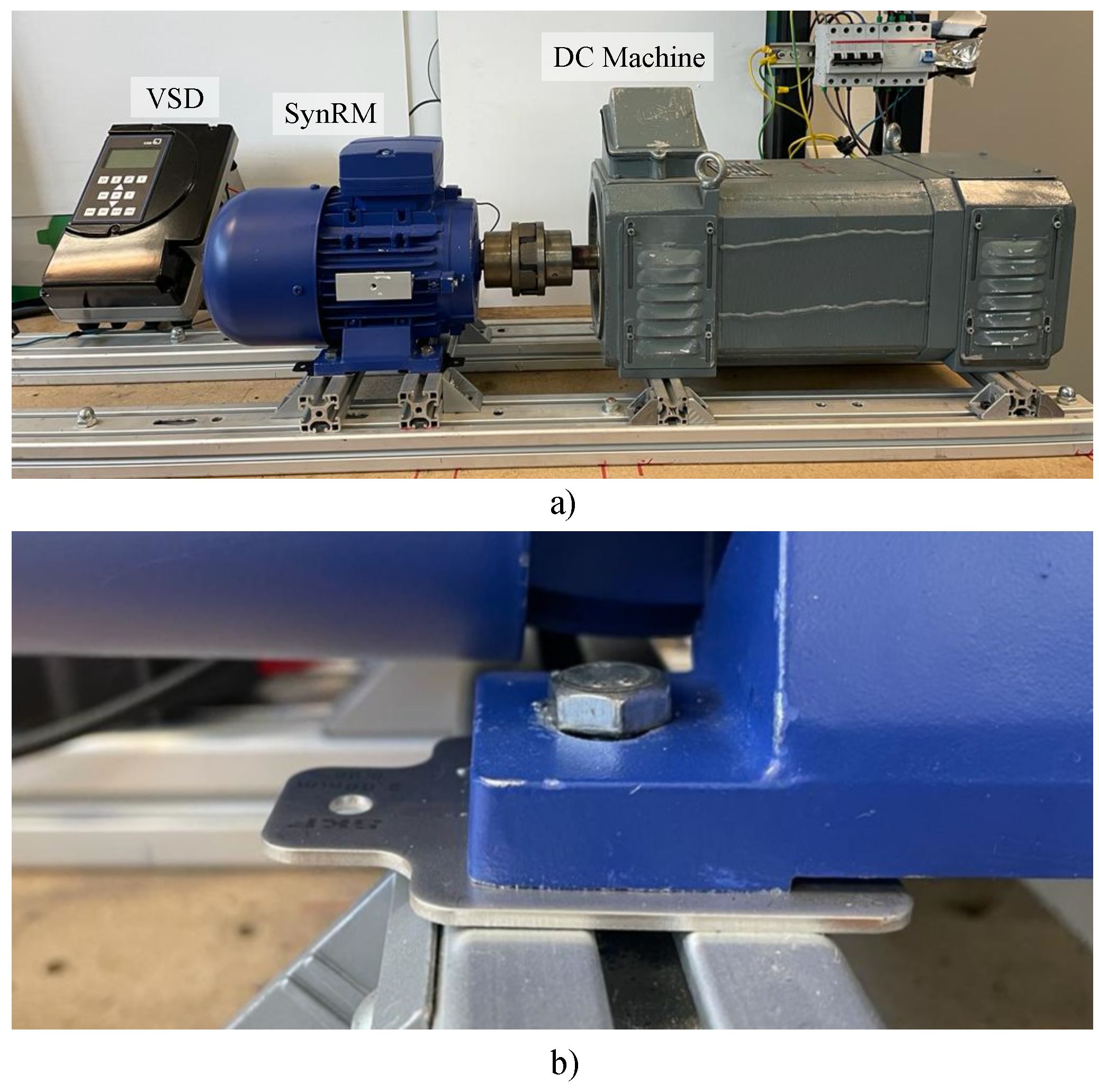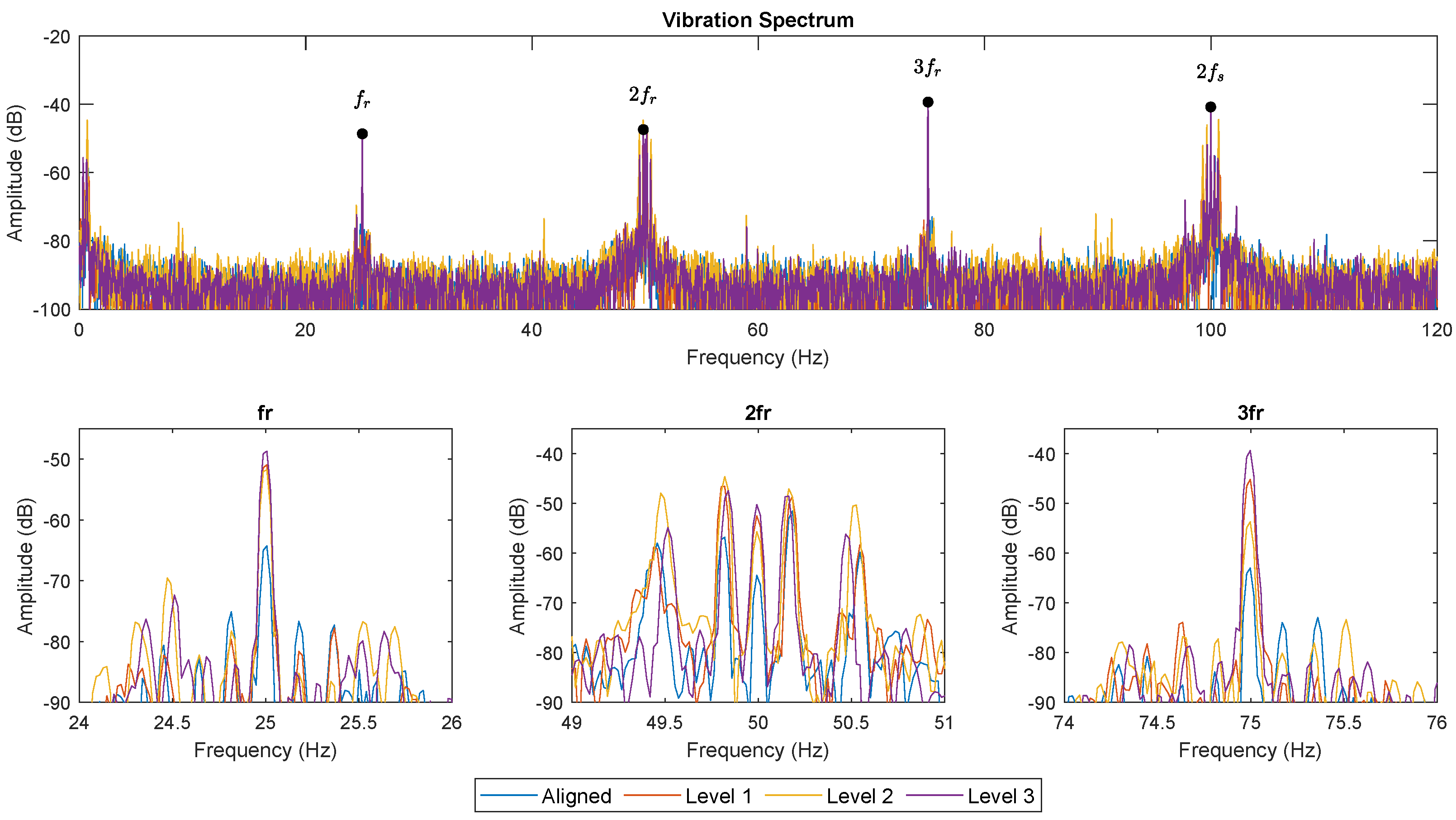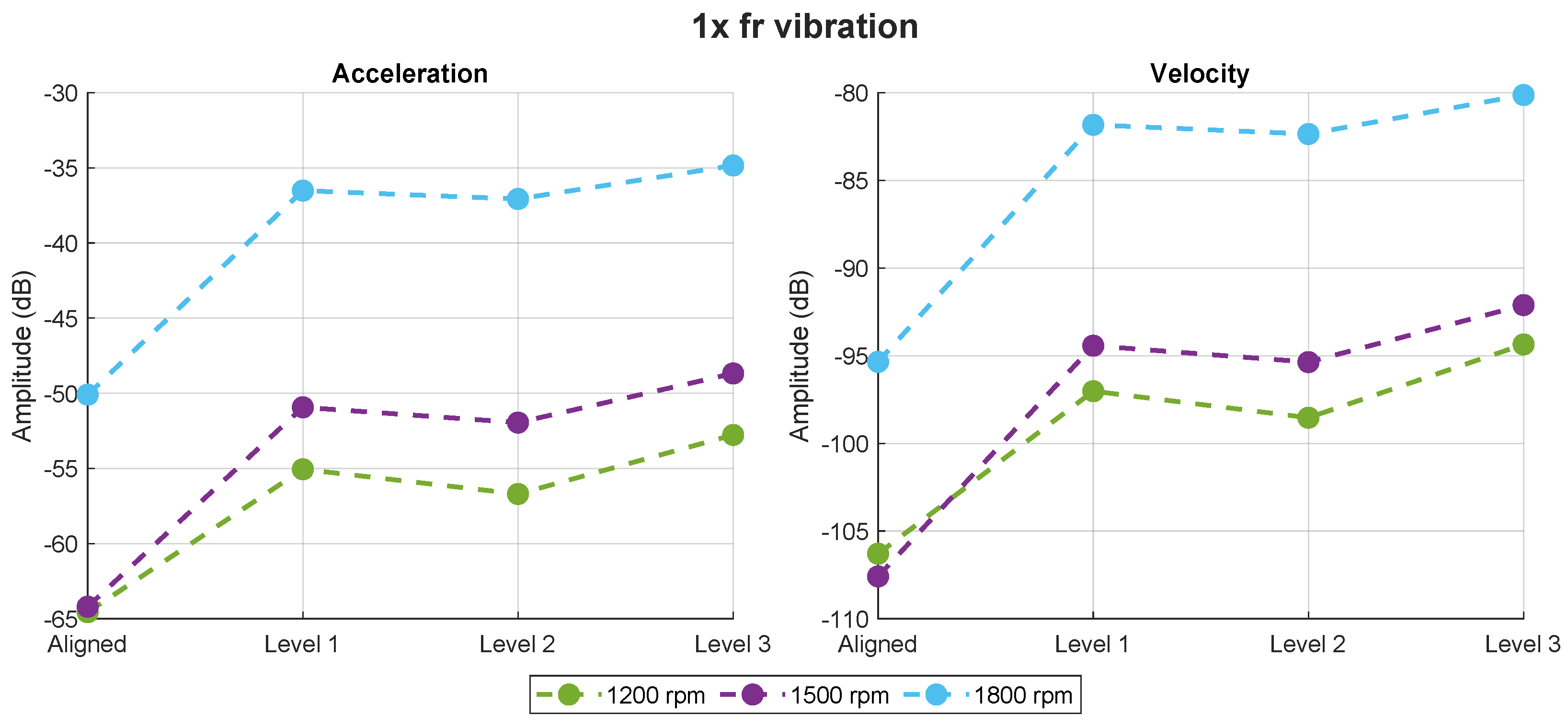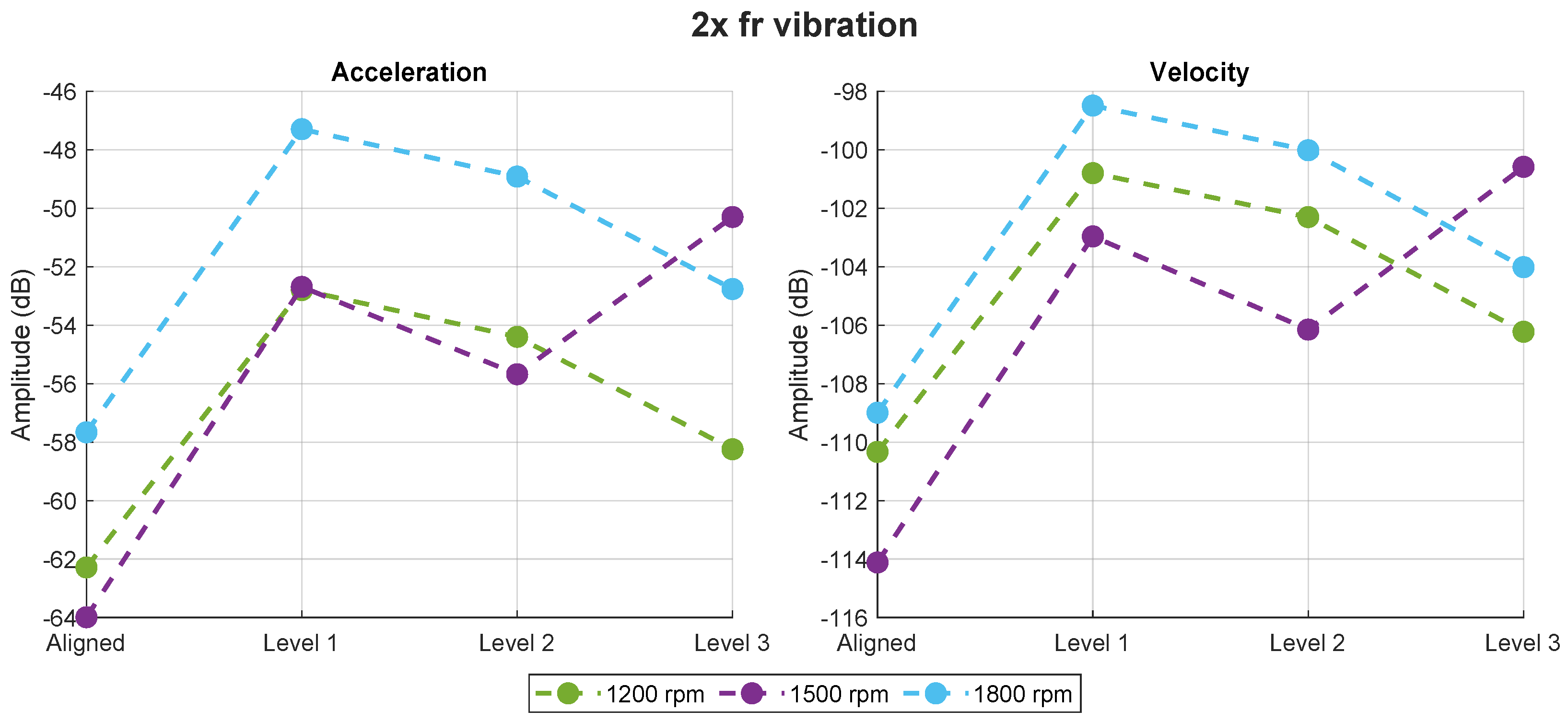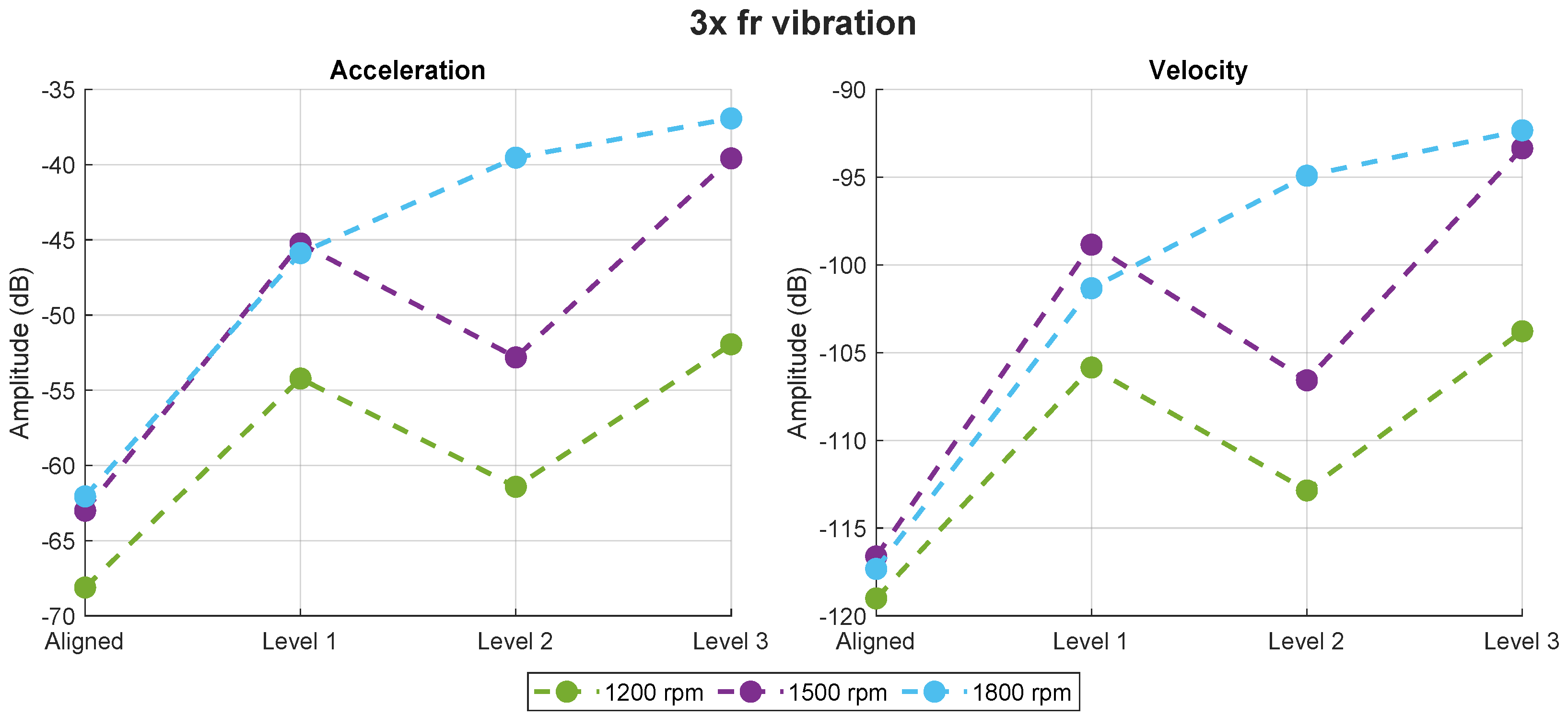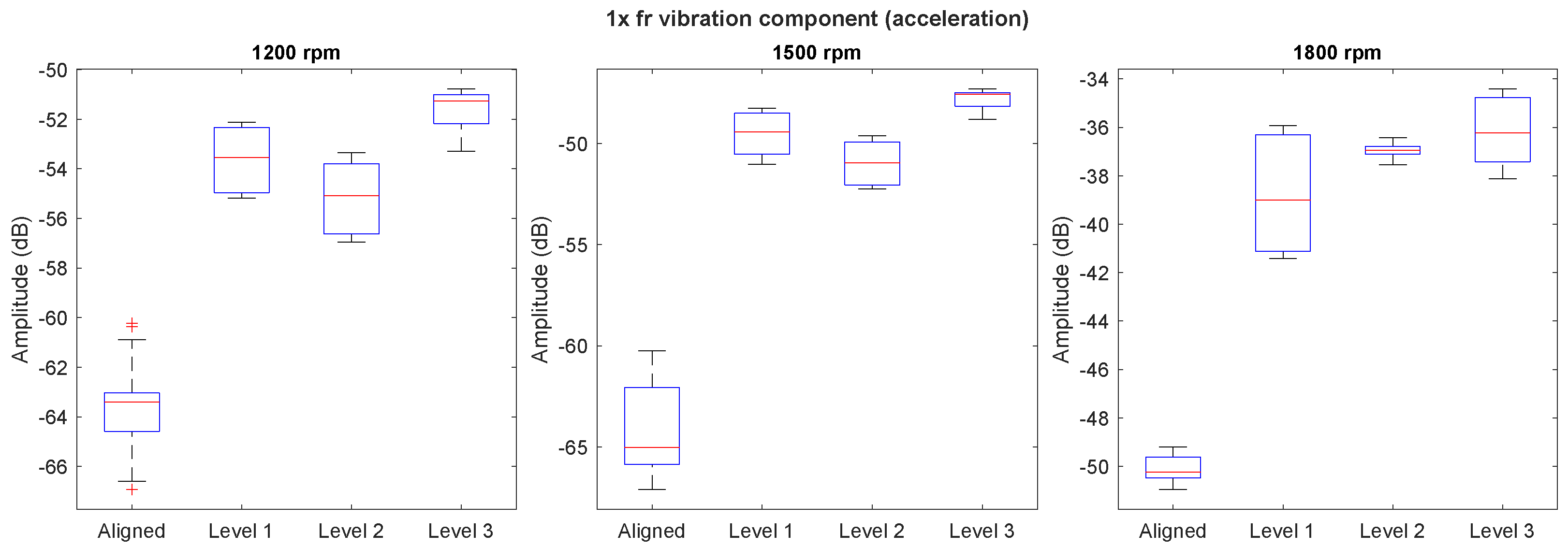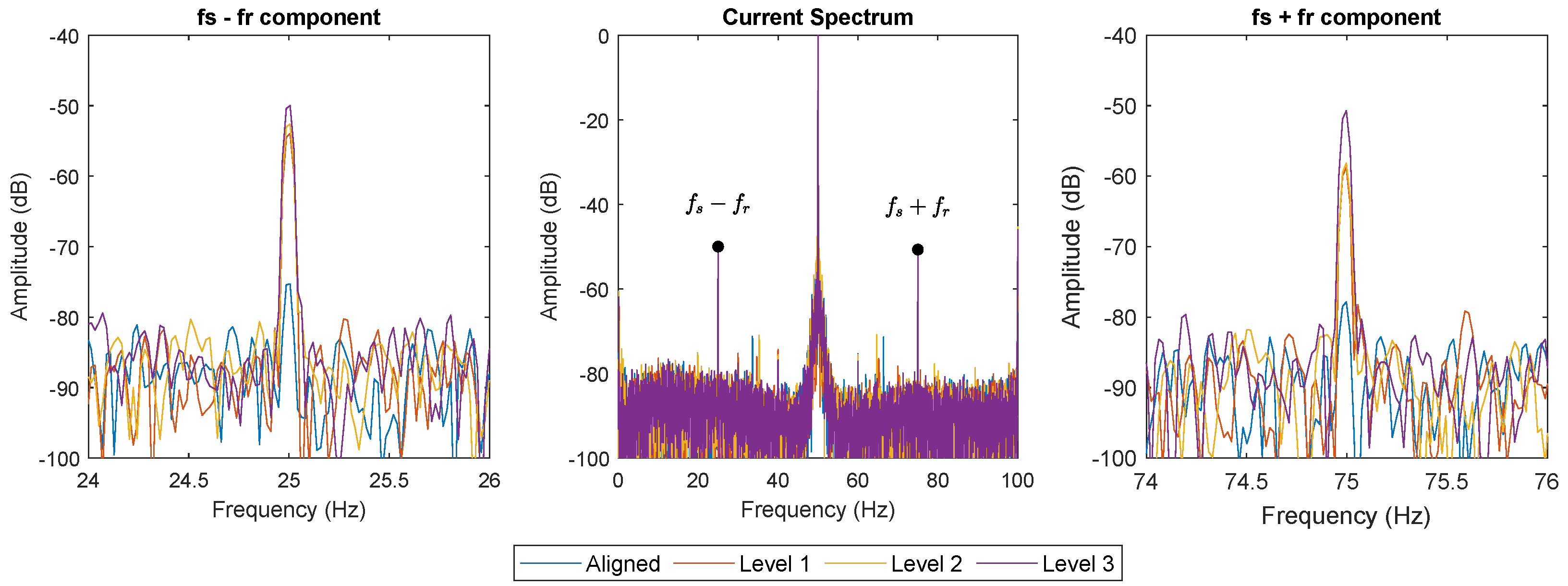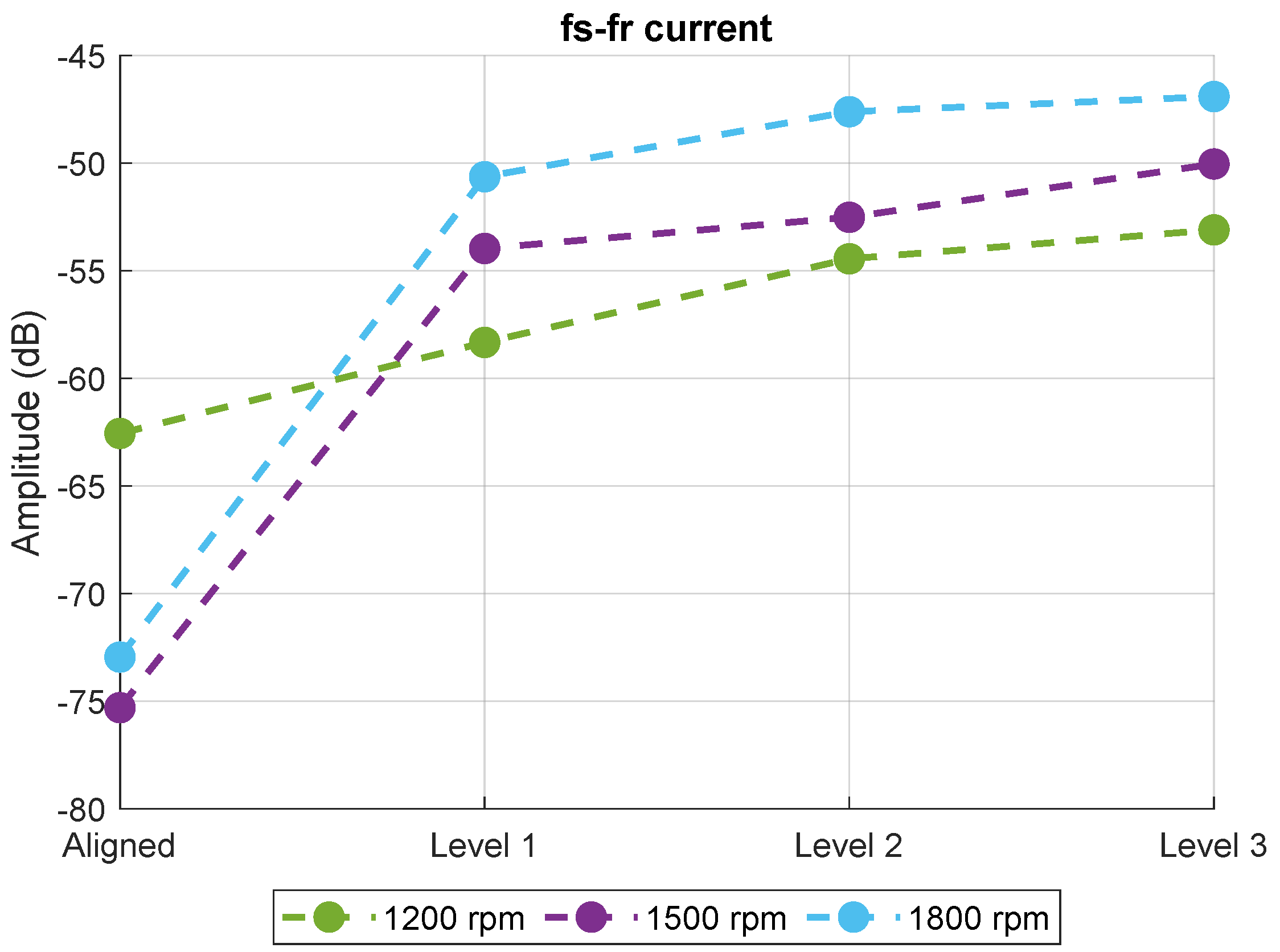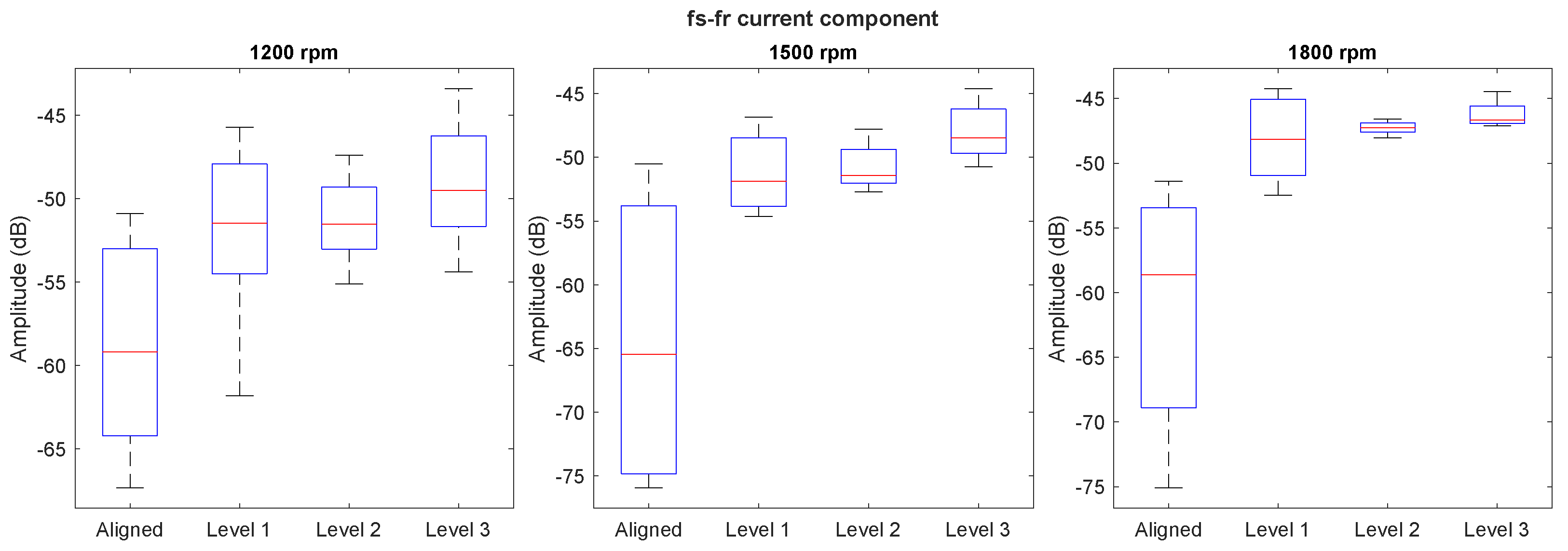4.1. Vibration Spectrum Analysis
Figure 4 shows the FFT analysis of the vibration signals captured under the steady-state regime when the motor is operating at 1500 rpm with nominal load. The results show the amplitude of the
,
, and
components for different levels of misalignment between the motor and the driven load: healthy (aligned with the load), level 1 (shims of 1 mm), level 2 (shims of 1.5 mm), and level 3 (shims of 2 mm) of angular misalignment in the vertical plane (XY plane).
Note that these frequencies appear even in the healthy state of the motor, although with a very low amplitude (around 65 dB); however, in all three cases, differences in amplitude are observed when there is a certain level of misalignment in the motor, indicating that these components are apparently related to the presence of misalignment in SynRMs.
A more detailed analysis is then performed, comparing the amplitude (in dB) of each of the analyzed components in the vibration spectrum (the , , and components) with the motor operating at different speeds of 1200, 1500, and 1800 rpm at nominal load (80% of nominal load when the motor operates at 1800 rpm), directly calculated from the acceleration signal and from the velocity signal obtained by integrating the acceleration signal. The figures compare the results of the aligned motor with each of the different misalignment levels studied.
Figure 5 shows the amplitude of the
rotational component in the vibration spectrum, directly calculated from the acceleration signal (left) and from the velocity signal (right). In general,
Figure 5 shows that the amplitude of the rotational component in the vibration spectrum increases when a certain level of misalignment is present in the motor even at low levels of misalignment. However, the results do not allow for a clear distinction between the lower misalignment levels, as the amplitude does not follow a consistent increasing trend but rather remains relatively stable. Moreover, for the same fault level, or even with the motor aligned, the amplitude increases with speed, meaning that higher speeds result in a greater amplitude of this component. As expected, these patterns remain the same when the results come from the velocity signal; however, the changes are much smaller compared to those obtained from the acceleration signal.
Table 5 presents the quantitative results of the
component in the vibration spectrum, obtained from both acceleration and velocity signals, calculating the percentage increase or decrease relative to the amplitude when the motor is aligned. The results confirm the relationship between the amplitude of
and the presence of misalignment in the motor. At lower speeds (1200 rpm), this increase is much smaller, reaching a maximum of 18% in the most severe misalignment case when analyzing the acceleration signal. These changes are much more pronounced at higher motor speeds, with an increase of around 20% for the lowest misalignment level. When comparing with the results obtained from the velocity signal, the changes are significantly lower, with a maximum amplitude increase of 16% at the highest misalignment level compared to the healthy condition, whereas for the same case, the increase in the acceleration signal reaches 30%. Therefore, the
vibration component is highly suitable for detecting misalignment in these motors. The results obtained from the acceleration signal are more pronounced than those observed with the velocity signal. Moreover, as misalignment increases, its effects on acceleration are more evident compared to vibration velocity, although the lowest misalignment levels cannot be distinguished.
Figure 6 shows the variation in the amplitude of the
component in the vibration spectrum of the acceleration and velocity signals. In both cases, the amplitude of the
component increases significantly when transitioning from the aligned motor to misalignment level 1. However, when the motor moves from misalignment level 1 to level 2, the amplitude of
remains stable and even decreases as the misalignment level increases. This trend continues, with the amplitude of the component decreasing when comparing misalignment level 1 to higher levels, except when the motor operates at 1500 rpm. In this particular case, the amplitude increases significantly, exceeding the amplitude observed at the first misalignment level. This indicates that the
component does not allow for a clear distinction between different misalignment levels and exhibits erratic behavior. Despite this, the reduction in amplitude does not overlap with the amplitude value observed when the motor is fully aligned.
Additionally,
Table 6 presents the quantitative values of the amplitude of the
component for each studied case. In this case, the data pattern is very similar to the one obtained with the
component, showing an amplitude increase relative to the healthy condition when misalignment is present. However, these changes are not very pronounced, reaching a maximum increase of 20% when the motor operates at 1500 rpm. Compared to the results obtained in
Table 5, these changes are much smaller, with the amplitude increasing by only 15% when misalignment is present in the motor at higher speeds, and in the case of the
, the percentage is around 20% under the same conditions. In practice, this is not entirely reliable for detecting this fault in this context.
Figure 7 show the results of the analysis of the
. Qualitatively, the two signals exhibit the same trend. The amplitude of the
component increases in the presence of misalignment. The difference between the aligned motor and misalignment level 1 is significant, with a noticeable amplitude increase at all studied speeds. Moreover, when the motor operates at high speeds (1800 rpm), these changes correlate with the level of misalignment, meaning that as misalignment severity increases, the amplitude of
also rises, allowing differentiation between fault levels. Conversely, at lower speeds (1200 and 1500 rpm), this behavior does not follow a linear pattern. The amplitude of
can indicate the presence of misalignment, but not its severity, as the amplitudes at misalignment levels 1 and 2 do not follow a clear progression.
As observed with the
and
components, this amplitude rise is more significant when analyzing the component from the acceleration signal. This is evident in
Table 7, which presents the quantitative results. The amplitude increases for each misalignment level compared to the aligned motor and is more pronounced when using acceleration-based analysis, particularly at 1500 and 1800 rpm. In the case of the motor operating at 1800 rpm, the increase reaches up to 40%. However, the rise is more gradual at 1200 rpm, with an 20% increase compared to the healthy condition. When analyzing velocity, the amplitude also increases compared to the aligned motor, but the variation is less pronounced.
Comparing the results for each studied rotational frequency multiple (
,
, and
), the most significant changes occur in the
component. The amplitude evolution follows a more stable and less erratic pattern than in the other cases. In all three cases, there is an amplitude increase at all speeds. However, these changes are more significant in the
component, especially when it is obtained from the acceleration signal. However, it must be noted that, contrary to what other studies suggest regarding the component
, this does not appear to be the most suitable component for detecting misalignment due to its erratic behavior in the presence of the fault. In
Figure 4, an enlargement of the vibration spectrum for each of the components studied is shown. In the case of the component
, sidebands around it are observed, which could be caused by an electromagnetic component. In [
21], it is explained that the power supply produces an electromagnetic force that results in a vibration frequency equal to twice the power supply frequency (
); in this case, this component coincides with the component
. When electromagnetic and mechanical frequencies coincide, components are observed around the coincident frequency (in the case of
Figure 4, this would be 100 Hz). A similar phenomenon could be responsible for the distributed components observed around the component
; however, these components have an unknown origin at the moment, and the physical identification of their origin is beyond the scope of this research.
Finally,
Figure 8 shows the boxplots corresponding to the distribution of the amplitude of the
component of the vibration signal (acceleration) for each of the studied speeds with different load levels. The boxplots are well separated and do not overlap when the motor is aligned and when there is some degree of misalignment. This indicates that the amplitude of the component clearly distinguishes the presence of misalignment for all the considered machine load levels. However, this indicator is not capable of misalignment severity identification.
4.2. Current Spectrum Analysis
Figure 9 shows the FFT analyses of the current signals captured under the steady-state regime when the motor is operating at 1500 rpm with nominal load. The results show the amplitude of the rotational frequencies,
and
, for different levels of misalignment between the motor and the driven load. Note that the considered fault components (
and
) present clear differences in their amplitudes between the healthy case and faulty conditions. In the case of the
component, the difference between the healthy condition and the most severe level of misalignment (level 3) is around 25 dB, which is an indication that the component is clearly related to misalignment. However, its amplitude remains stable between the different levels of misalignment. The same happens with the
component. The difference between the healthy condition and the third level of misalignment is around 30 dB, similarly to what happen with the other component. Both components show an increase in their amplitude when there is a certain level of misalignment, but their amplitude does not increase as the level of misalignment worsens.
Figure 10 shows the amplitude of the
component in the current spectrum when the motor is operating under different speeds at nominal load. The general trend is that the amplitude of this component increases when there is misalignment between the motor and the driven load. This effect is more significant at higher speeds; at 1500 rpm and 1800 rpm, the changes between the aligned and misaligned motor are more abrupt. However, these changes are smaller when the motor operates at lower speeds, specifically at 1200 rpm. Regarding the differences between failure levels, the most significant change occurs when the motor transitions from the healthy state to level 1 misalignment. As misalignment increases, the amplitude of this component shows a slight increase; however, these changes are quite small, and qualitatively, it remains relatively stable, especially at higher speeds. This suggests that this component is useful for detecting the presence of misalignment but is not sufficient to determine the severity of the fault.
Figure 11 shows the amplitude of the
component in the current spectrum when the motor is operating at different speeds under nominal load. Similarly to the
component, at higher speeds (1500 rpm and 1800 rpm), the amplitude increases significantly when the motor transitions from being aligned to experiencing a slight level of misalignment. However, this does not occur at lower speeds. At 1200 rpm, the amplitude decreases in the healthy state and the initial misalignment levels, behaving erratically. In fact, the amplitude in the healthy state is around −55 dB, and when the motor operates at 1500 rpm with level 1 misalignment, the value is even lower. At 1200 rpm, the amplitude only increases when misalignment reaches the highest level, and even then, this increase is not significant, as it appears to rise by only 3 dB compared to the aligned motor. Regarding the differences between the various misalignment levels at higher speeds, at levels 1 and 2, the amplitude remains unchanged and even decreases slightly in the second case. These results broadly indicate that this component is not suitable for detecting the presence of misalignment in SynRMs.
Table 8 shows the amplitude values of the
components of the current signal when the motor operates at different speeds under nominal load. Additionally, this table also shows the percentage of increase or decrease in the amplitude for each of the studied fault levels (different levels of misalignment) compared to the healthy state (aligned motor). The general trend is that as the motor’s fault level increases, the amplitude of the components tends to rise in all cases. This indicates a correlation between the amplitude of these components and the presence of misalignment in the motor. Comparing the different speeds, it is observed that the increase in amplitude is much lower at lower speeds. In this case, at 1200 rpm, the amplitude of the
component increases by only 15% when the motor has a level 3 misalignment, meaning the highest misalignment level. However, the
component increases by just 5.7% under the same conditions and even exhibits erratic behavior at lower misalignment levels, sometimes decreasing in amplitude. When the motor operates at higher speeds, the amplitude increase is much more significant in all cases, suggesting that at higher motor speeds, the impact of the fault is more noticeable. Additionally, the increase in the
component is particularly significant at these speeds, reaching up to 35% at the highest misalignment levels. Overall, the percentage increase in amplitude is greater as the fault level rises, although the variations between different levels are only about 4 dB for the
component. In the case of the
component, the changes between different misalignment levels do not follow a clear trend, as in some cases, the increase is greater at level 1 than at level 2.
Figure 12 shows the boxplots corresponding to the distribution of the amplitude of the
component during steady-state operation at different speeds and various load levels. When considering different load levels, the amplitude of the boxplots varies significantly, indicating that the amplitude of this component depends on the load level. Despite this, the
component allows for distinguishing whether misalignment is present, as the median trend (represented by the red line in the boxplot) increases when a certain level of misalignment occurs. However, it is not entirely possible to differentiate between the various failure levels, as the amplitude remains stable across them.


